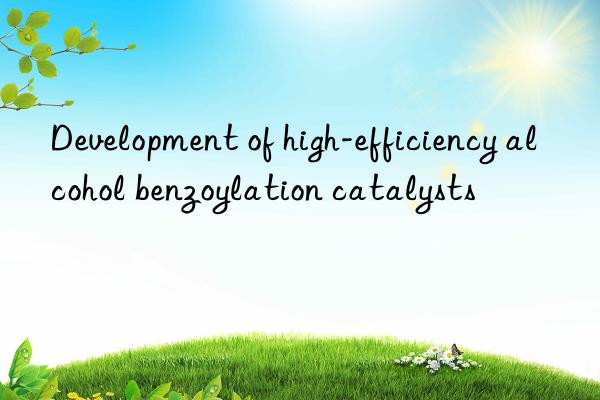
Benzoylation of alcohols is an important step in organic synthesis and is widely used in the production of drugs, spices, dyes and other fine chemicals middle. This reaction usually involves the reaction of an alcohol with a benzoic acid derivative (such as benzoyl chloride or benzoic anhydride) in the presence of a catalyst to form the corresponding benzoate ester. Efficient alcohol benzoylation catalysts can not only speed up the reaction rate, but also improve product selectivity and yield, while reducing the formation of by-products, which is of great significance for realizing industrial production. This article will discuss the development of highly efficient alcohol benzoylation catalysts, including catalyst types, mechanisms of action, performance optimization strategies, and green chemistry considerations.
Catalyst types and mechanisms of action
Traditional inorganic catalysts
- Lewis acids: Such as aluminum chloride (AlCl3), boron trifluoride (BF3), etc., can activate benzoyl chloride and promote its reaction with alcohol.
- Solid acids: including zeolites (such as HZSM-5) and supported metal oxides (such as 20%InCl3/Si-MCM-41), which provide acidic sites to promote the protonation and protonation of alcohols. Esterification reaction.
Organic Catalyst
- Organic bases: Such as 4-dimethylaminopyridine (DMAP), triethylamine (TEA), etc., which accelerate the esterification process of alcohol by forming active intermediates with benzoyl chloride.
- Phase transfer catalyst: Such as quaternary ammonium salts and crown ethers, which accelerate the reaction by promoting contact between substrates.
Performance optimization strategy
Improve catalytic efficiency
- Catalyst loading: By loading the catalyst on a high surface area carrier (such as γ-Al2O3, SiO2), the number of active sites is increased and the catalytic efficiency is improved.
- Structural modification: For example, doping and modifying the pore structure of zeolite can enhance the acidity and stability of the catalyst.
Improve selectivity and yield
- Cocatalyst addition: The introduction of cocatalysts (such as lanthanum complexes and strontium complexes) can adjust the electronic properties of the main catalyst and improve product selectivity.
- Optimization of reaction conditions: Control temperature, pressure and solvent to reduce side reactions and increase the yield of the target product.
Green chemistry considerations
Green chemistry principles are crucial in the development of efficient catalysts for the benzoylation of alcohols, aiming to reduce environmental impact and improve resource utilization efficiency.
Environmentally friendly catalyst
- Metal-organic frameworks (MOFs): Highly porous and tunable, they can serve as green, recyclable catalysts.
- Enzyme catalysis: Using biological enzymes such as lipase to achieve highly selective alcohol benzoylation reaction under mild conditions.
Mild reaction conditions
- Microwave-assisted catalysis: Use microwave heating to quickly activate reactions and reduce energy consumption and reaction time.
- Electrochemical Catalysis: Accelerate reactions through electric fields and reduce the use of harmful chemicals.
Solvent replacement
- Aqueous phase catalysis: Perform alcohol benzoylation reaction in water to reduce the use of organic solvents and reduce pollution.
- Supercritical fluid: For example, supercritical carbon dioxide, as a green solvent, improves reaction conditions and facilitates product separation.
Conclusion
Developing high-efficiency alcohol benzoylation catalysts is a multidisciplinary research field involving chemical engineering, materials science, environmental science, etc. aspects. By rationally designing the catalyst structure, optimizing the reaction conditions, and following the principles of green chemistry, the efficiency, selectivity, and environmental friendliness of the alcohol benzoylation reaction can be significantly improved. Future research directions will focus on the innovative design of catalysts, in-depth understanding of catalytic mechanisms, and feasibility assessment of industrial applications, in order to achieve widespread application and sustainable development of alcohol benzoylation reactions in the production of fine chemicals. With the advancement of science and technology and the popularization of the concept of green chemistry, we have reason to believe that future alcohol benzoylation catalysts will be more efficient, economical and environmentally friendly, bringing revolutionary changes to the chemical industry.
Extended reading:
T120 1185-81-5 di(dodecylthio) dibutyltin – Amine Catalysts (newtopchem.com)
DABCO 1027/foaming retarder – Amine Catalysts (newtopchem.com)
DBU – Amine Catalysts (newtopchem.com)
bismuth neodecanoate – morpholine
amine catalyst Dabco 8154 – BDMAEE
2-ethylhexanoic-acid-potassium-CAS-3164-85-0-Dabco-K-15.pdf (bdmaee.net)



 微信扫一扫打赏
微信扫一扫打赏
